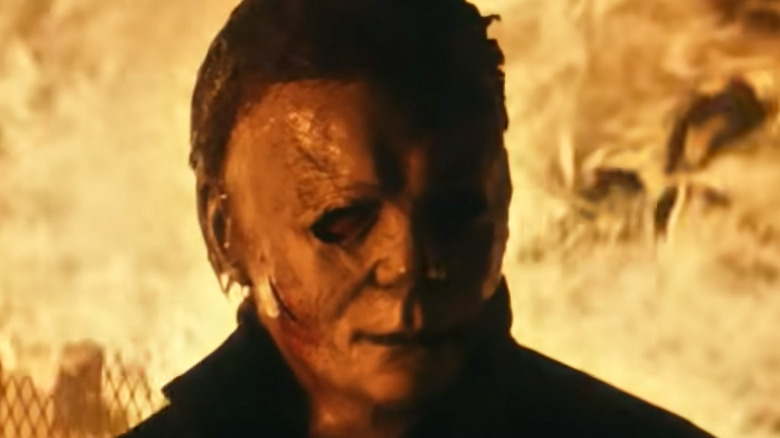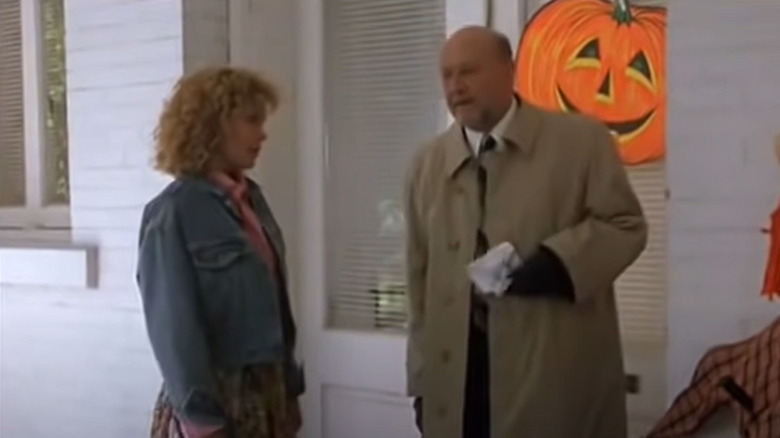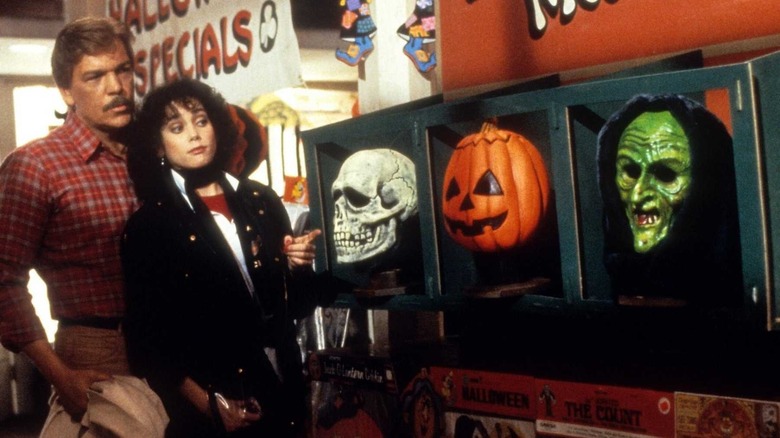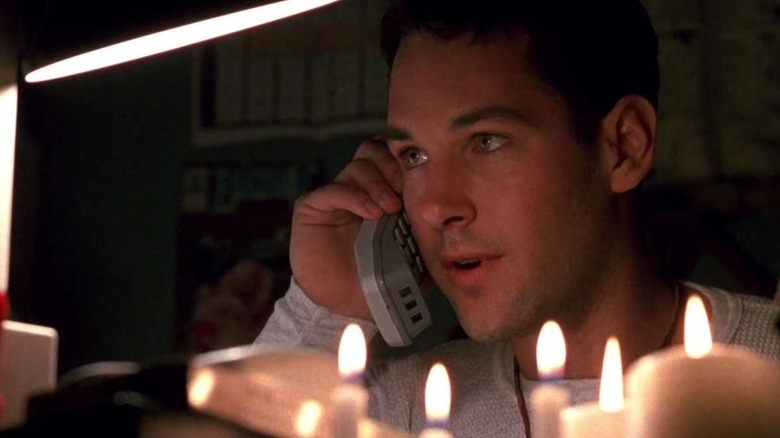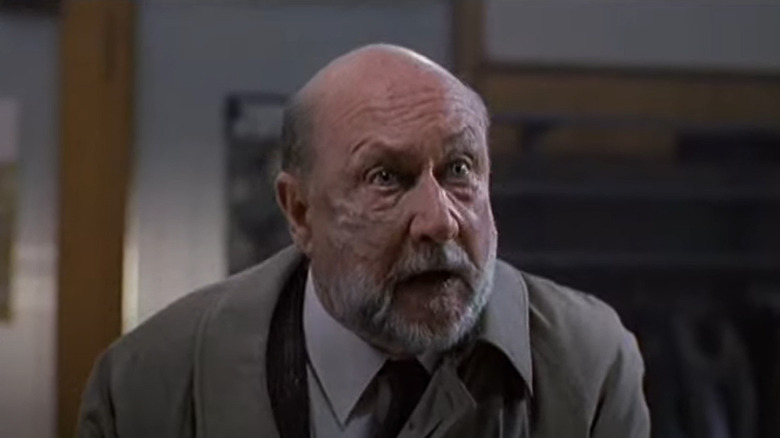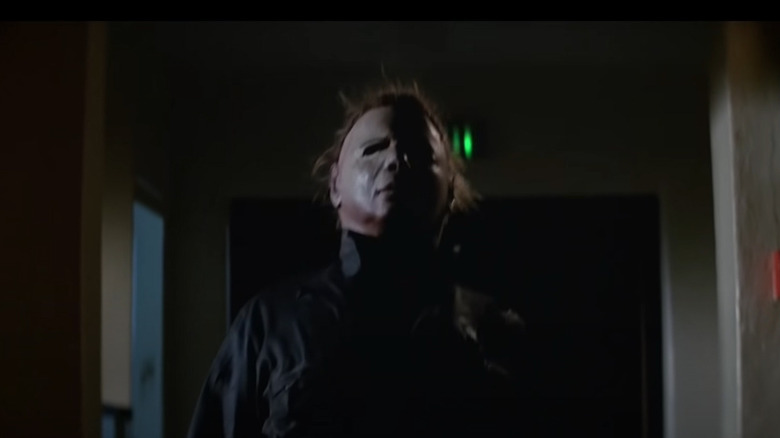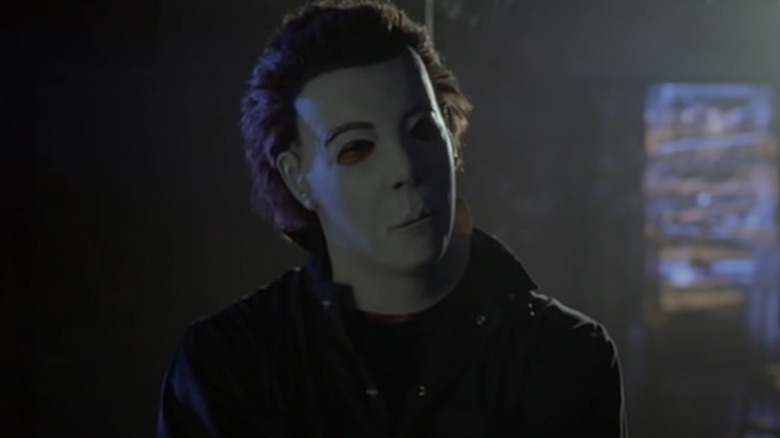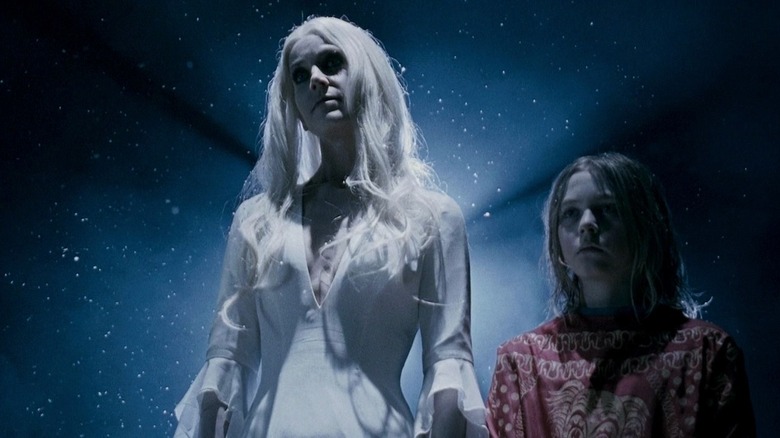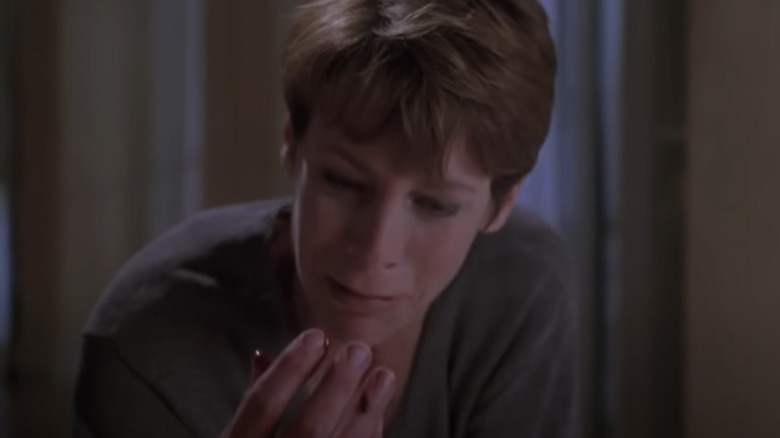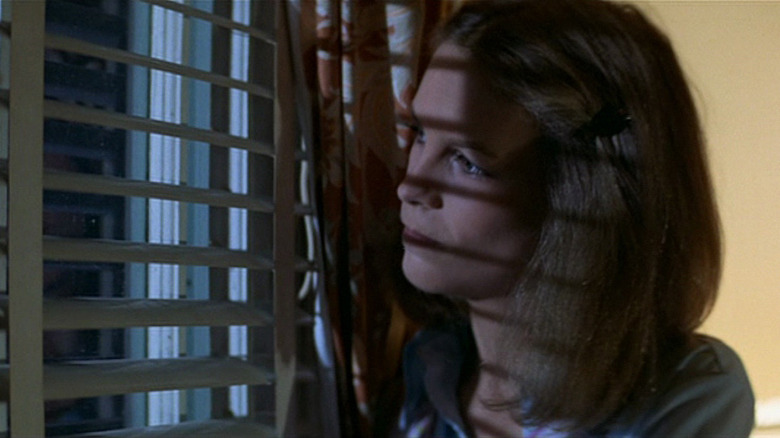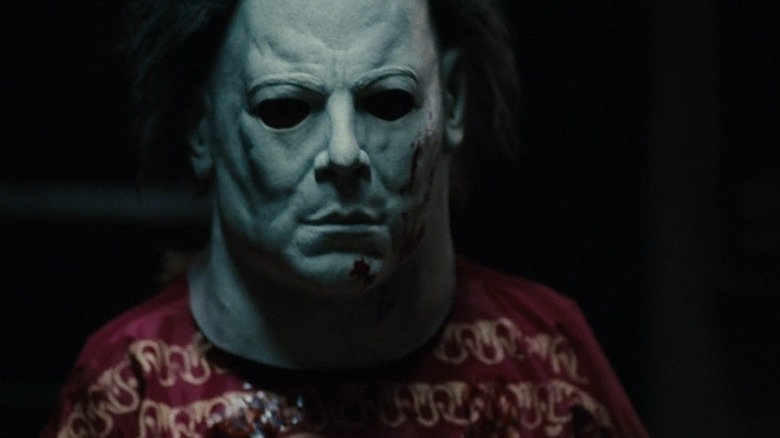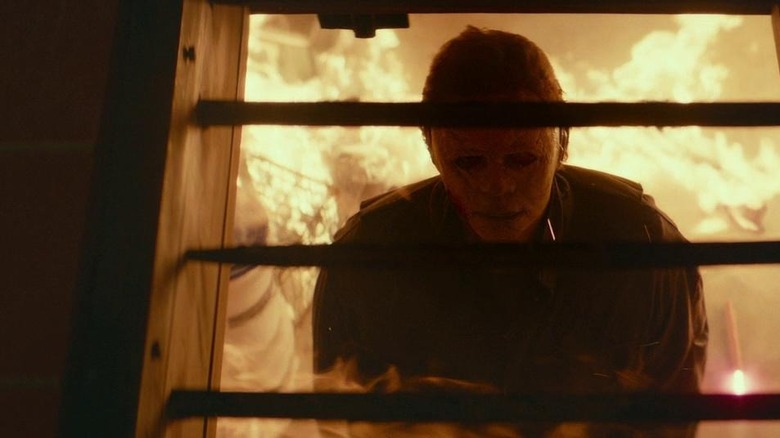Halloween Franchise Movies Ranked By How Much Money They Made
Michael Myers has had a lengthy stay in the pop culture zeitgeist. The steady presence of the "Halloween" franchise in movie theaters has ensured his status as a horror icon: Moviegoers simply haven't had the opportunity to forget about him, as he's always carving up new victims on the big screen. However, just because this franchise has run since 1978 and seen several box office hits along the way doesn't mean it's devoid of financial hardship. Certain entries in this series have come up noticeably short at the box office — consider the infamous "Halloween III: Season of the Witch," the only installment in the series to totally eschew Michael Myers. Others, in contrast, have become so successful, they broke box office records.
When one takes a concerted look at how each "Halloween" movie has fared financially, many questions about the series emerge. Why were certain installments resoundingly rejected by moviegoers, while others deeply resonated? How attached are viewers to Laurie Strode? How interested is the audience in Michael Myers' twisted, blood-stained backstory? Join us as we answer these questions by ranking the "Halloween" franchise movies by how much money they made.
11. Halloween 5: The Revenge of Michael Myers
Every horror movie franchise has its box office nadir. For the "Halloween" series, that point came at the end of the '80s, a decade that propelled the slasher movie to new heights of success. Though "Halloween 4: The Return of Michael Myers" restored some of the franchise's financial mojo a year prior, 1989's "Halloween 5: The Revenge of Michael Myers" brought things crashing back to Earth with a paltry $11.6 million worldwide haul. Though it only cost $6 million to make, its inability to earn double its budget meant that this was the rare "Halloween" installment that actually lost money for its financiers.
How did the series go south so fast at the box office? Part of it has to do with when "Halloween 5" was released. Coming just one year after its predecessor, audiences weren't craving more Michael Myers action. There's also the fact that 1989 was not a kind year for slasher sequels. Shortly before "Halloween 5" hit theaters, The Los Angeles Times observed that new installments in the "Nightmare on Elm Street" and "Friday the 13th" sagas had also suffered franchise-low hauls at the box office. As the curtain fell on the 1980s, audiences were growing weary of the horror series that defined this era of filmmaking. Such weariness ensured that "Halloween 5" would occupy the unenviable position of being the "Halloween" saga's rock bottom at the box office.
10. Halloween III: Season of the Witch
After the release of "Halloween II," the franchise's producers came up with an idea: What if the next one didn't feature Michael Myers? "Halloween," the thinking went, could become an annual anthology series (via Collider), with each installment focusing on a brand-new tale divorced from the story of Michael Myers and Laurie Strode. Kicking this trend off would be 1982's "Halloween III: Season of the Witch," which focuses on a conspiracy to use masks to melt children's faces off on Halloween night. Obviously, this is a touch removed from the exploits of prior "Halloween" films, but the risk was taken regardless.
The desire to do something different, rather than repeat the past in "Halloween III: Season of the Witch" is admirable. But moviegoers didn't turn out for the ambitious production. The movie's marketing didn't emphasize its distinct premise enough, nor did it put its memorable scares on people's radars. Thus, the people who did turn up left the theater confused over where the heck Michael Myers was. This feature grossed just $14.4 million worldwide, a 43% drop from the global gross of "Halloween II." That sharp decrease killed any and all grand plans for a "Halloween" anthology franchise.
9. Halloween: The Curse of Michael Myers
After six years off the big screen, Michael Myers returned with a vengeance in 1995's "Halloween: The Curse of Michael Myers." This installment was plagued by a tumultuous production marked by the death of longtime series cast member Donald Pleasence. There's also the fact that the "Halloween" franchise was nearly 18 years old by the time "Halloween: The Curse of Michael Myers" hit theaters. Franchises that last this long are either permanent fixtures of the moviegoing scene or long-in-the-tooth sagas that need to be retired.
"The Curse of Michael Myers" actually got off to a solid start at the domestic box office, which is a testament to the enduring appeal of the "Halloween" brand name. However, it proved to be an extremely front-loaded affair and grossed just $15.1 million worldwide. Audiences looking for intense scares in the fall of 1995 didn't check out the new "Halloween" movie, they went and saw "Se7en." It's easy to imagine the two films being able to coexist at the box office, but the weaker word-of-mouth for "The Curse of Michael Myers" made "Se7en" stronger in comparison, and yet another obstacle this title couldn't overcome. With a box office haul this meek, the "Halloween" franchise was at one of its lowest ebbs.
8. Halloween 4: The Return of Michael Myers
After trying out something different in "Halloween III," the franchise decided it was time to bring its classic baddie back in 1988's "Halloween 4: The Return of Michael Myers." Being the first movie in seven years to feature this slasher icon, "Halloween 4" registered as something of an event for "Halloween" devotees. Unfortunately, the ubiquity of this franchise and the 1980s slasher movie genre as a whole ensured that "Halloween 4" wasn't appealing enough to become a box office hit.
In its theatrical run, "Halloween 4" grossed $17.7 million globally. This is a noticeable improvement over "Halloween III," and more than triple the film's $5 million price tag. Unfortunately, it also earned noticeably less money than the first two "Halloween" movies managed to rake in. Bringing Michael Myers back provided a boost, but without anything else to offer (not even the return of Jamie Lee Curtis' Laurie Strode), "Halloween 4" was probably always going to be limited in terms of its box office potential. Still, at least this installment broke even, which prevented the "Halloween" series from slipping into an even more pronounced downward spiral.
7. Halloween II (1981)
In 1978, the first "Halloween" movie was an underdog that ended up changing the horror movie landscape forever. This was a film that had to prove itself to the general public, rather than lean on a familiar brand name. Cut to 1981 and the release of "Halloween II," and the dynamics had changed sharply. By this point, everyone knew who Michael Myers was, and the public was begging for more movies about him. In the face of so many imitators, it was time for the "Halloween" franchise to come back and show everyone who was the true king of horror movie mountain.
"Halloween II" ended up grossing $25.5 million globally, a total that is roughly one-third of what its predecessor amassed. That was likely inevitable, since the success of the first "Halloween" was an unpredictable event buoyed by word-of-mouth. The more mixed critical reception received by "Halloween II" also ensured it would be a lower-grossing title at the box office. On its minimal budget of $2.5 million, however, "Halloween II" still proved to be a profitable venture for all involved. Plus, it managed to be much bigger than almost all other 1981 horror movies, including a new entry in the "Friday the 13th" franchise. "Halloween II" wasn't as much of a success as the first film, but it still left other scary features in the dust. As a result, it guaranteed that the "Halloween" series wasn't anywhere near finished.
6. Halloween: Resurrection
When it first hit theaters in 1978, "Halloween" was a movie so singular, other features tripped over themselves to imitate it. Unfortunately, it also spawned a series of sequels that turned the once-unpredictable Michael Myers into a cliché. These diminishing returns got so bad, by the time 2002's "Halloween: Resurrection" hit theaters, the "Halloween" franchise was chasing horror movie trends in questionable ways, rather than defining them.
"Halloween: Resurrection" arrived as the influence of "Scream" was still inspiring genre-savvy meta-horror titles. As a result, the movie's plot concerns a reality program in which contestants have to stay in a house once occupied by Michael Myers. Full of winks and nods to general pop culture and the "Halloween" franchise, "Halloween: Resurrection" is a movie that could only have been made in 2002. It was also not something audiences raced out to see, as it grossed just $37.6 million worldwide. The film was technically profitable, given its $15 million budget, but it suffered a severe drop in gross from its predecessor, "Halloween H20: 20 Years Later." Worst of all, it signified just how far the "Halloween" franchise had fallen since Michael Myers first stalked the silver screen. If there were going to be future "Halloween" movies, they'd have to be better than this.
5. Halloween II (2009)
Horror movie remakes became de rigueur in the 2000s, as titles like 2003's "The Texas Chainsaw Massacre" and 2009's "Friday the 13th" can attest. While the 1970s and 1980s incarnations of these films spawned countless sequels, though, these remakes proved harder to craft profitable follow-ups for. 2006's "The Texas Chainsaw Massacre: The Beginning," for example, made way less than its 2003 predecessor. The novelty of seeing a new take on a beloved horror movie was enough to get the attention of moviegoers once, apparently, but not necessarily twice. Enter "Halloween II," the 2009 sequel to Rob Zombie's 2007 "Halloween" remake.
"Halloween II" continued Zombie's unorthodox and brutal vision of Michael Myers and his world. But while the novelty of a new take on "Halloween" was enough to launch the 2007 film to box office success, it didn't inspire the affection necessary to carry its sequel to box office glory. "Halloween II" carved up just $38.5 million worldwide, half its predecessor's global sum. As "Halloween II" opened just one week after "The Final Destination" hit theaters, one wonders if it just couldn't compete with the latter film's combination of distinctively gruesome deaths and then-novel 3D trickery.
4. Halloween H20: 20 Years Later
Long before David Gordon Green tried the same trick in 2018, 1998's "Halloween H20: 20 Years Later" explicitly targeted audiences' nostalgia. This turned out to be a solid idea: "Halloween H20" did indeed manage to beef up the franchise's box office by going back to 1978's basics, complete with the return of Jamie Lee Curtis and the kid Laurie Strode once babysat (now played as an adult by Paul Rudd). This was great for fans and marketers: Instead of giving moviegoers another so-so installment full of freshly doomed teenagers, "Halloween H20" promised them a direct continuation of the most beloved entry in the horror saga.
As a result, "Halloween H20" managed to make $55 million worldwide, more than triple its $17 million budget. This is also more than double the worldwide hauls of all prior "Halloween" installments, save the original film from 1978. Though it debuted outside of October, the natural launchpad for "Halloween" movies, the film's August release turned out to be wise, given the dearth of competing horror films in that month. No wonder the 2018 "Halloween" film also decided to go down the nostalgia route — it worked like gangbusters for "Halloween H20."
3. Halloween (1978)
There weren't major expectations for 1978's "Halloween," the original film in the franchise. An independent horror feature from an unknown filmmaker with no major names in its cast, no one would have been shocked if it had come, gone, and vanished without making much of an impact. But "Halloween" surpassed its modest origins to become one of the most seminal horror movies in film history. The quality on display from director John Carpenter was so immediately apparent to moviegoers that it generated the sort of word-of-mouth filmmakers spend their whole lives dreaming of.
Costing just $325,000 to make, "Halloween" eventually grossed $70.2 million over multiple theatrical releases. As pointed out by Time Magazine, at the time, this made "Halloween" the most lucrative independent feature in history, and a total game-changer for what was possible outside mainstream Hollywood. Furthermore, as IndieWire observed in 2018, the film was one of the highest-grossing movies of 1978, and remains one of the most successful R-rated horror movies ever made. "Halloween" wasn't just lucrative by the standards of cheap horror flicks, it was a box office phenomenon. Many films have tried to replicate the success of "Halloween," but few have proved to be as unpredictably lucrative.
2. Halloween (2007)
After "Halloween: Resurrection" failed to make much of a splash, the horror franchise went into dormancy for a few years. But as the disturbing likes of "Saw" and "Hostel" began dominating the big screen, it was really only a matter of time before Michael Myers returned to retake his spot at the top. This inevitability finally came to pass with 2007's "Halloween," a remake masterminded by Rob Zombie. It douses the legend of Michael Myers in a bleak color palette and injects a detailed backstory that attempts to explain why, exactly, he's such a brutal psychopath.
The resulting film earned critics' scorn, but proved to be an unqualified success at the box office. "Halloween" enjoyed a big Labor Day opening (via Deadline) that set it up for a $77.5 million worldwide run. Giving the "Halloween" franchise a breather apparently allowed anticipation to build for future installments, while going the remake route shaped the 2007 "Halloween" to then-current horror trends. The "Halloween" franchise might have been on life support just a few years prior, but Rob Zombie's vision gave Michael Myers a whole new lease on life.
1. Halloween (2018)
By 2018, Blumhouse Productions had churned out many box office hits. But tackling sequels to classic properties was something new, as the production company had largely focused on shepherding fresh franchises like "Insidious" and "The Purge." Still, Blumhouse opted to go down the route of reviving an icon by crafting a sequel to 1978's "Halloween." This installment takes a bold tack by disregarding all other sequels in the franchise. So long, Rob Zombie reboot, and farewell to the concept of Michael Myers' being Laurie Strode's sibling. It was time to get back to basics.
What resulted is a movie that plays like the "Force Awakens" of horror sequels. 2018's "Halloween" arrived on a tide of nostalgia-fueled marketing that hammered home Jamie Lee Curtis' return to the franchise. Unsurprisingly, this made "Halloween" into a big fat box office hit that grossed $255.3 million globally. "Halloween" had no trouble surpassing the worldwide hauls of all prior "Halloween" installments. As an additional feat, "Halloween" also exceeded the box office sum of the first "Scream" flick, making it the most successful slasher movie of all time (via MovieWeb). "Halloween" didn't just revive Michael Myers as a box office draw — it reimagined his franchise for a new generation of horror hounds.
